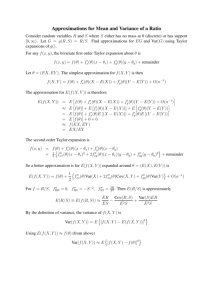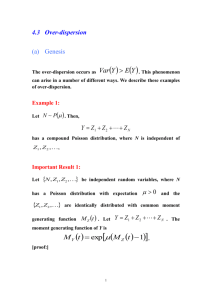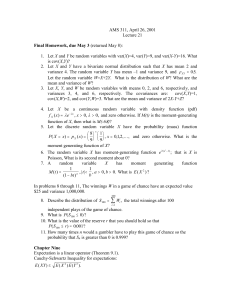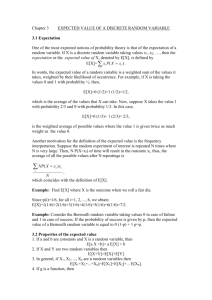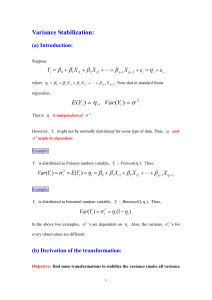ch2.5
advertisement
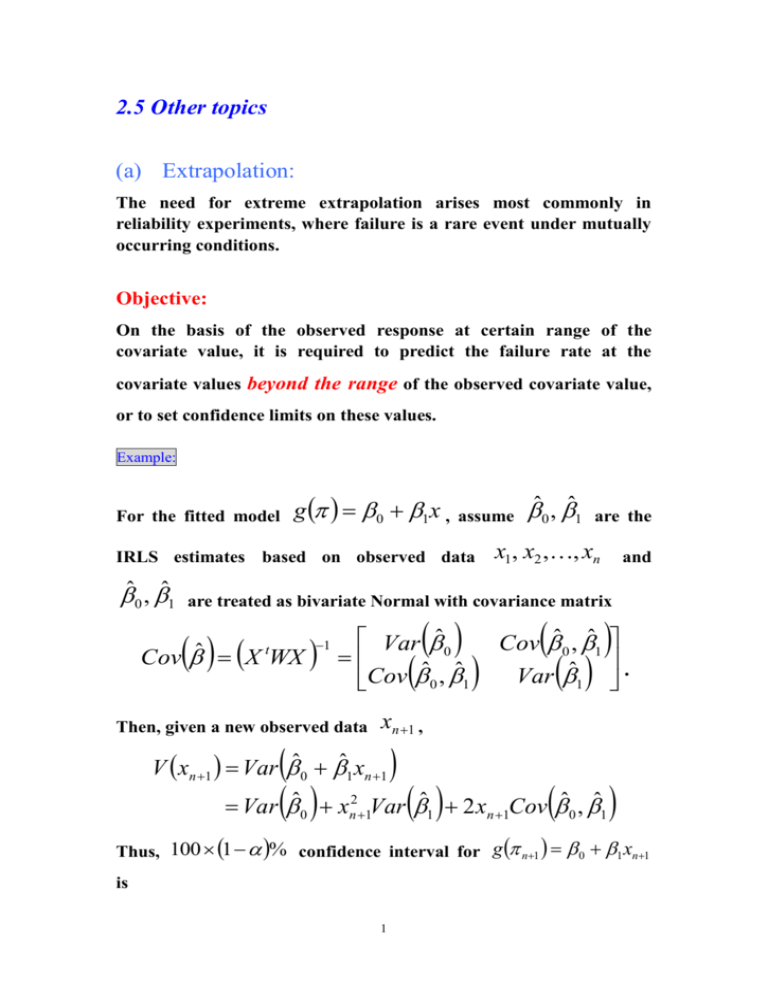
2.5 Other topics (a) Extrapolation: The need for extreme extrapolation arises most commonly in reliability experiments, where failure is a rare event under mutually occurring conditions. Objective: On the basis of the observed response at certain range of the covariate value, it is required to predict the failure rate at the covariate values beyond the range of the observed covariate value, or to set confidence limits on these values. Example: For the fitted model g 0 1x , assume IRLS estimates based on observed data ˆ0 , ˆ1 ˆ0 , ˆ1 are the x1 , x2 ,, xn and are treated as bivariate Normal with covariance matrix Cov ˆ X tWX 1 Then, given a new observed data Var ˆ0 ˆ ˆ Cov 0 , 1 Cov ˆ0 , ˆ1 Var ˆ1 . xn 1 , V xn 1 Var ˆ0 ˆ1 xn 1 Var ˆ0 xn21Var ˆ1 2 xn 1Cov ˆ0 , ˆ1 Thus, 100 1 % confidence interval for g n1 0 1 xn1 is 1 ˆ0 ˆ1 xn 1 g n 1 z1 V xn 1 g n 1 ˆ0 ˆ1 xn 1 V xn 1 z1 , ˆ0 ˆ1 xn 1 V xn 1 z1 On the other hand, given a failure probability 0 , the 100 1 % confidence “interval” is the set of all x0 -values satisfying ˆ0 ˆ1 x0 g 0 V x0 z1 . (b) Over-dispersion: By the term “over-dispersion”, it means the variance of the response Yi exceeds the nominal variance mi i 1 i . Note: Some would maintain that over-dispersion is the norm in practice and nominal dispersion the exception. Note: Over-dispersion can arise in a number of ways. The simplest and the most common is clustering in the population. (I) Over-dispersion for clustering: Assume for simplicity that the cluster size is equal to k and the sample size is equal to m. Thus, there are m clusters. Let k Z j ~ bk , j be the number of positive respondents in the j’th 2 cluster. Then, the total number of positive respondents is Y Z1 Z 2 Z m k . Assume j is a random variable with E j , Var j 2 1 . Therefore, unconditional mean and variance of Y are mk mk mk E Y E Z j E E Z j | j E k j j 1 j 1 j 1 m k E j k k j 1 m m k and Var Y E Var Y | 1 , , m Var E Y | 1 , , m k k mk mk E Var Z j | j Var k j j 1 j 1 mk m E k j 1 j k 2 2 1 k j 1 3 mE E k m 1 m 1 k m 1 mE j 1 j k 2 m 1 2 j j 2 2 2 2 m 1 2 m 1 k 2 m 1 m 1 k 1 2 m 1 m 1 1 k 1 2 m 1 2 where 2 1 k 1 2 . Note: If 0 2 1 , then 1 2 k m . (II) Parameter estimation: In practice, it seems unwise to rely on a specific form of over-dispersion, particularly where the assumed form has been chosen for mathematical convenience rather than scientific plausibility. Assume that the effect of over dispersion is E Y m , Var Y 2 m 1 . That is, the mean is unaffected but the variance is inflated by an unknown factor 2 . Then, the method in section 2.3, (b), may still be used as if the binomial distribution continued to apply. The differences are the following: 1 Cov ˆ 2 X tWX , mi D y1, y2 ,, yn , ~1, ~2 ,, ~n 2 2n p and 4 D y1 , y2 ,, yn , ˆ 01 , ˆ 02 ,, ˆ 0 n D y1 , y2 ,, yn , ˆ a1 , ˆ a 2 ,, ˆ an 2 2 tends to 1 . The only problem left is the estimation of 2 . There are two possible cases: Replication: Suppose for each covariate value of xi , several observations yi1 , mi1 , yi 2 , mi 2 ,, yir , mir , are observed. Let i ri ~ i yij j 1 ri mij . j 1 Then, si2 ~ 2 ri yij mij 1 i ~ 1 ~ ri 1 j 1 mij i i The estimate of 2 is n s2 r i i 1 n 1si2 r i 1 5 i 1 . Absence of replication: The estimate of s 2 2 1 n p is n i 1 yi miˆ i X2 miˆ i 1 ˆ i n p 2 Note: If mi 1 for each i, the estimate of 2 based on Pearson’s statistic does not have a close approximation of true 6 2 .





